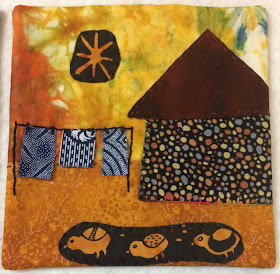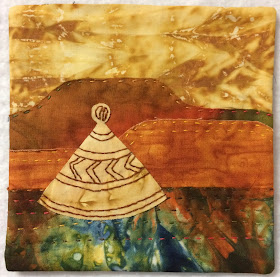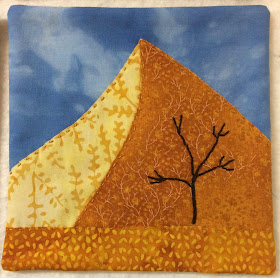There are fifteen 6" x 6" small works in this grouping, each one telling a story about my African travels. They will eventually be mounted on canvases and hang together at my July solo exhibit (more about that later) - A Sense of Colour - where they will be for sale. Here are the close-ups and a little of what I was thinking when I made them.
Every adventure starts with the first few steps into the unknown, willingly taking the risks in order to experience something new - seeing new lands, meeting new people, eating new foods, thinking new thoughts - all of it starts with that spirited stepping forth.A map is a guide, but there will always be choices. Choosing one thing means saying no to something else. And even when we think we know where we're going, we can and will be surprised by the unexpected.
Seeing my first elephant and first baobab tree are remembered here - the soft feet of the elephant stepping almost noiselessly beside our vehicle, as he walked along the road; and the twisty, lovely ugliness of the baobab.
These rondavels with their thatched roofs that are typical in Lesotho They're cool in summer and warm in winter. Blankets (represented by Shweshwe cloth) have been washed and hung to dry.
The flat-topped mountains of the land and distinctive straw hats and wool blankets of the Basotho identify them as people of the "Kingdom in the Sky".
In most African countries, women carry enormous loads on their head, walking with such grace and dignity, often with a baby carried on their back. This square was made in honour of these unforgettable women.
Swaziland - this is their national shield - is a neighbouring country to Lesotho, green and treed in comparison to Lesotho's barren countryside. We visited it often.
The Matopos hills in Zimbabwe have an air of mystery to them. We walked among the huge boulders, the height of several people, wondering how they came to be there. The printed zebras are an old, old Zimbabwe design, evidence of a highly sophisticated culture that existed long before British colonialism.
Small stalls selling fruits and vegetables are set up in even the smallest villages, each person hoping to sell a few tomatoes or jackfruit or bananas.
When I visited Tanzania and took the ferry to Zanzibar for the day, these elegant dhows, or fishing boats, glided past.
The sand dunes of Namibia were breathtaking. And in the midst of the desert, with sand as far as the eye could see, there would be an occasional bare bones tree bravely struggling to survive.
The cowrie shells of Ghana were once used for currency, and are still a symbol of wealth and prosperity. I love the shape of them.
One game walk we took, on foot, was in search of the white rhinos of South Africa, almost extinct now. When we came upon two in a ravine, I wasn't sure if I was pleased or not by the discovery, in spite of the gun the guide was carrying.
In Uganda, men often use bicycles as a way to transport bananas and pineapple and other produce to market. Huge amounts are balanced precariously on either side of both wheels and in front of the handlebars.
And lastly, these impalas. They are not as sought after as other African wildlife, but to see a herd of them leaping through the tall grasses, their golden underbellies revealed with each jump, was a sight to behold. I wanted to make a square just for them.
Now that I've finished these, I'm freed up to work on something else. It's a good feeling. The urge to start something brand new is upon me, but I'm hoping that reason prevails and that I get back to work on another of my "to-be-finished in 2018" projects. Here's hoping . . . !

















I love your narration of these pieces - it made them so personal yet helped me connect to them.
ReplyDeleteI wondered if I had said too much, so am glad to hear that the stories helped you to connect with the work. Thanks for letting me know.
DeleteI agree with Lee. Your brief description tells me how connected you feel to the experience you're picturing.
ReplyDeleteThat's helpful feedback, Jaynie. Thank you.
Delete